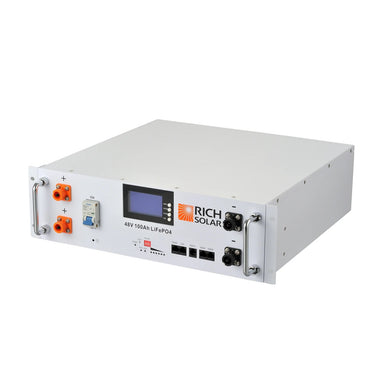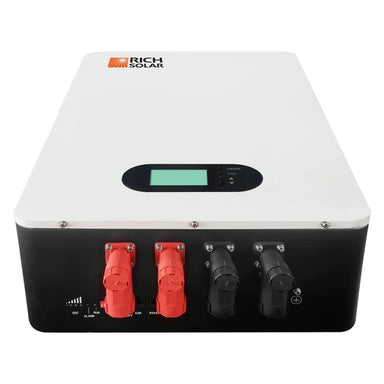

Power Your Server With Unmatched Performance And Reliability: Introducing The Rich Solar Alpha 5 Server Lithium Iron Phosphate Battery Finally,...
View full details
888-976-5443 | M-F 9am-5pm AZ MST
support@outboundpower.com
888-976-5443
M-F 9am-5pm AZ MST
support@outboundpower.com
Deep-cycle batteries are a type of rechargeable battery designed to provide sustained power over an extended period of time. Unlike regular car batteries, which are designed to provide a burst of energy to start an engine, deep cycle batteries are designed to deliver a steady, low-level current for an extended period of time.
These batteries are typically used in applications where a consistent and reliable power supply is needed, such as in marine, RV, and off-grid solar power systems. They are also used in electric vehicles and for backup power in homes and businesses.
Deep-cycle batteries are constructed with thicker plates and denser active material, which allows them to withstand repeated charging and discharging cycles. They are also designed to be discharged to a lower state of charge than other types of batteries without damaging the battery's performance or lifespan. This makes them ideal for applications where the battery will be discharged and recharged frequently.
SLA batteries, also known as valve-regulated lead-acid (VRLA) batteries, are maintenance-free as they are designed with a sealed enclosure and utilize a recombination process to control the release of gases. They are spill-proof and can be mounted in any orientation. Absorbent Glass Mat (AGM) and Gel batteries are two common types of SLA batteries.
AGM batteries use a highly porous glass mat separator that absorbs and immobilizes the electrolyte. This design enhances the battery's vibration resistance, allows for faster charging and discharging rates, and reduces the risk of acid leakage. AGM batteries are suitable for a wide range of applications and offer good overall performance.
Gel batteries use a silica-based gel that suspends the electrolyte. This gel immobilizes the electrolyte and makes the battery more resistant to vibration and deep discharges. Gel batteries are known for their excellent cycle life, low self-discharge rate, and ability to perform well in high-temperature environments. They are commonly used in deep-cycle applications where maintenance-free operation is required.
Li-ion batteries have gained popularity due to their high energy density, lightweight, and long cycle life. They offer a significantly higher depth of discharge (DOD) compared to lead-acid batteries, which means more usable capacity. Li-ion batteries also have a higher charge efficiency and can be charged and discharged at faster rates. They are commonly used in portable electronics, electric vehicles, and renewable energy systems. However, they are typically more expensive than lead-acid batteries.
LiFePO4 batteries, a specific type of lithium-ion battery, offer improved safety and thermal stability compared to other lithium-ion chemistries. They have a longer cycle life, greater tolerance for high temperatures, and are less prone to thermal runaway or fire hazards. LiFePO4 batteries are commonly used in applications where safety and longevity are critical, such as electric vehicles, solar energy storage systems, and marine applications.
Each type of deep-cycle battery has its advantages and considerations, and the choice depends on factors such as the specific application, required capacity, cycle life, cost, maintenance requirements, and safety considerations.

 Save $-1,599.99
Save $-1,599.99
Power Your Server With Unmatched Performance And Reliability: Introducing The Rich Solar Alpha 5 Server Lithium Iron Phosphate Battery Finally,...
View full details
 Save $-1,999.99
Save $-1,999.99
The Rich Solar Alpha 5 Powerwall Will Empower Your Entire Home With Sustainable Energy Take control of your energy independence and experience a fu...
View full detailsQuality solar panels
Thank you so much for your review! We're thrilled that you're satisfied with your solar panels. Your support means a lot to our team and helps us continue improving our offerings. We look forward to serving you again in the future!
EcoFlow DELTA Pro Ultra Battery
Thank you for your 5-star rating! We always appreciate hearing from happy customers and we are please you are satisfied with the Delta Pro Ultra Battery. Please feel welcome to let us know if we can be of further assistance!
Runs my entire house with ease. A/C, Dryer, Furnace, lights, TVs ect…combine it with the smart home panel 2 and you won’t be in the dark ever! When the power goes out it instantly switches to the backup.
Thank you for your fantastic review of the DELTA Pro Ultra Battery! We're thrilled to hear that it's powering your entire home so effortlessly, even handling heavy-duty appliances like your A/C and dryer. Pairing it with the Smart Home Panel 2 truly makes for an unbeatable backup solution.
It’s awesome to know you’re never left in the dark—literally! If you ever have any questions or want to explore more ways to optimize your system, we’re just a message away. Thanks again for choosing Outbound Power, and happy powering!
Got the best price on new EcoFlow products. Very quick shipping and great follow-up on FedEx status.
Thank you very much for your kind review. It was our pleasure to be of service and we are thrilled you are happy with your experience!
I bought two River 2 Pros from Outbound Power to give as Christmas presents to my two sons. I am very satisfied with my purchase and the price. Additionally, i found Outbound Power to be a reliable and good company to deal with.
(I already had a River 2 Pro, so can testify that i really love the versatility and portability and it holds a good amount of power suitable for almost any occasion. With ease, (it weighs only 17 pounds), I can use it at home or put it in my vehicle when taking trips.
As a side note: Additionally, i have other EcoFlow products (Delta Pros) and am very satisfied with them. From my experience, I have found EcoFlow to be a good company who produces good products and stands by their customers. I just had one of my Delta Pros repaired and EcoFlow stood by me every step of the way.
Thank you for such a glowing review of the EcoFlow RIVER 2 Pro and your experience with Outbound Power. We're thrilled that you're satisfied with your purchase and chose us for such thoughtful Christmas gifts for your sons—what an amazing gesture!
It's wonderful to hear how much you appreciate the portability and versatility of the RIVER 2 Pro and how it complements your other EcoFlow products like the Delta Pros. Your kind words about EcoFlow's customer support and reliability echo our goal to provide you with top-tier products and service every step of the way.
If there’s anything we can assist you with or if you’re eyeing more EcoFlow gear, don’t hesitate to reach out. Wishing you and your family a fantastic holiday season powered by EcoFlow!

